This website contains affiliate links. Some products are gifted by the brand to test. As an Amazon Associate, I earn from qualifying purchases. The content on this website was created with the help of AI.
Transform your space into a minimalist haven in five strategic steps. Start by decluttering completely and deep cleaning to create your blank canvas. Next, invest in fewer but higher-quality pieces that’ll stand the test of time. Embrace a neutral color palette with subtle textures and thoughtful accents to maintain visual serenity. Master your storage with multi-functional furniture and smart vertical solutions that keep spaces open. Finally, curate meaningful decor pieces that tell your story while maintaining breathing room. These foundational principles will guide you toward a more intentional, design-forward lifestyle.
Key Takeaways
- Begin with a thorough decluttering process, removing unnecessary items and organizing remaining belongings into clear categories for a fresh start.
- Select high-quality, multi-functional furniture pieces that serve essential purposes and maintain lasting value over trendy alternatives.
- Create a calming atmosphere with neutral colors like whites, beiges, and grays, adding texture for visual interest without excess decoration.
- Implement smart storage solutions using vertical space and multi-purpose furniture to maintain clutter-free living areas.
- Choose meaningful decor sparingly, limiting to 2-3 significant pieces per room while emphasizing negative space for visual balance.
Start With a Clean Slate
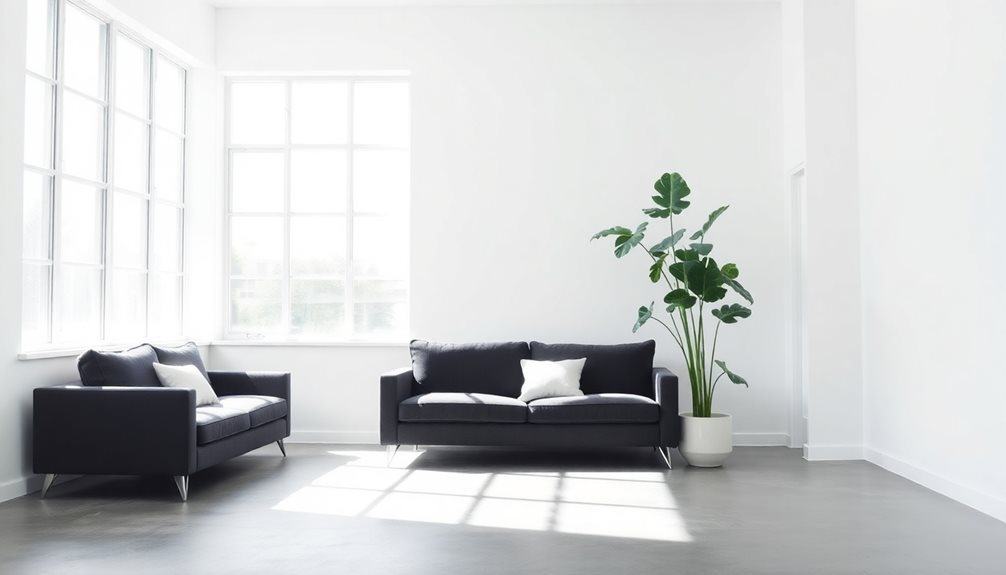
Before diving into minimalist design, you’ll need to declutter and cleanse your space completely. Take everything out of the room you’re transforming – from furniture to decor pieces, right down to the smallest trinkets. This radical reset allows you to assess each item’s value and necessity with fresh eyes.
Sort your belongings into three distinct categories: keep, donate, and discard. Be ruthlessly honest about what serves a purpose in your life. That decorative bowl you haven’t touched in years? Let it go. Those excess throw pillows cluttering your sofa? Keep only what’s essential. Remember, minimalism isn’t about creating an empty space – it’s about curating a thoughtful one.
Once you’ve filtered your possessions, deep clean every surface. Wash the windows to maximize natural light, scrub the floors until they shine, and repair any imperfections in the walls. This thorough cleaning creates the perfect blank canvas for your minimalist vision. Think of your space as a gallery where each remaining piece will have room to breathe and purpose to serve. Your mindful selection process now will set the foundation for a truly intentional design. Consider installing vertical storage solutions to maintain your newly decluttered space while maximizing available room.
Choose Quality Over Quantity
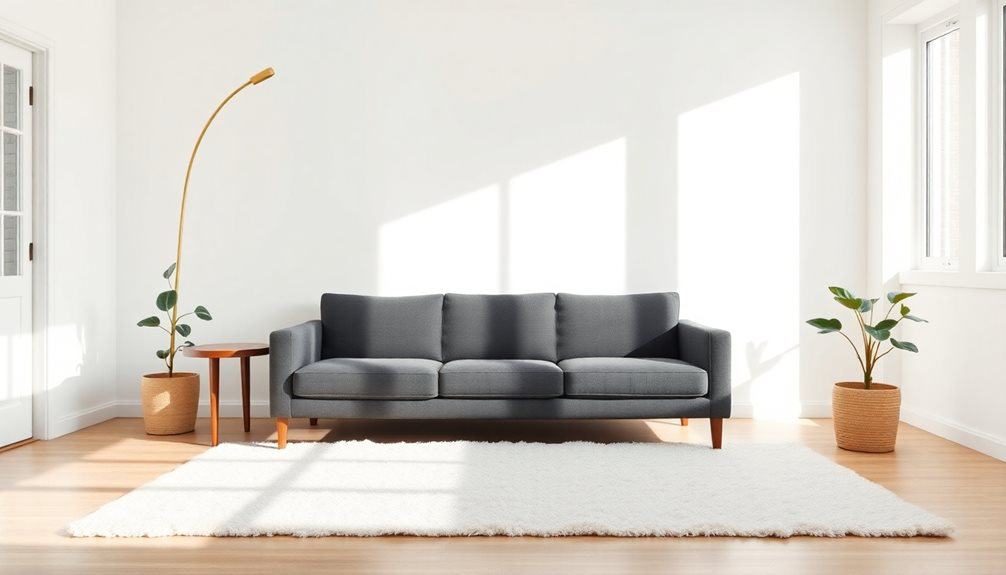
Investing in high-quality pieces forms the cornerstone of minimalist design. When you’re curating your space, focus on selecting well-crafted furniture and decor that’ll stand the test of time. Look for solid wood construction, premium textiles, and expert craftsmanship that’ll maintain their beauty and functionality for years to come.
Don’t fall into the trap of filling your space with trendy, disposable items. Instead, opt for timeless pieces that serve multiple purposes. A handcrafted oak dining table can double as a workspace, while a premium leather sofa becomes more beautiful as it develops a natural patina. Consider materials like brass, marble, and natural fibers that age gracefully and maintain their aesthetic appeal.
When shopping, examine the details: dove-tail joints in drawers, reinforced seams in upholstery, and the weight of materials. You’ll find that investing in fewer, better-quality pieces not only aligns with minimalist principles but also proves more cost-effective over time. Remember, each item should earn its place in your home through both its functionality and its ability to bring lasting value to your carefully curated space. Transform your living areas with stunning wood decor that adds warmth and natural elegance to any room.
Embrace Neutral Color Palettes
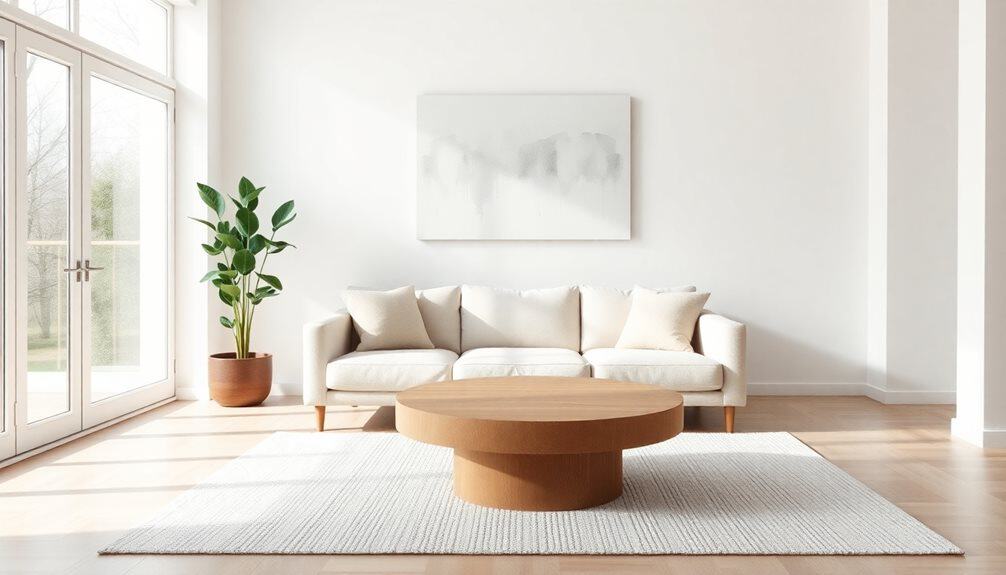
A well-executed neutral color palette serves as the foundation of minimalist design, creating a sense of calm and visual harmony throughout your space. Focus on soft whites, warm beiges, rich taupes, and subtle grays as your primary colors. These versatile hues work together seamlessly while providing enough contrast to keep your rooms from feeling flat or lifeless.
Layer your neutral tones strategically by incorporating different textures and materials. Consider a cream-colored linen sofa against light gray walls, or pair white oak furniture with warm beige curtains. You’ll want to include at least three varying neutral shades in each room to create depth and visual interest.
Don’t shy away from incorporating black or charcoal accents – they’ll ground your space and add sophisticated contrast to lighter neutrals. Think matte black hardware, dark picture frames, or charcoal throw pillows. When selecting your neutral palette, pay attention to undertones. Warm undertones create coziness, while cool undertones offer a more contemporary feel. Test paint samples in different lighting conditions, as neutrals can shift dramatically from day to night.
Master Functional Storage Solutions
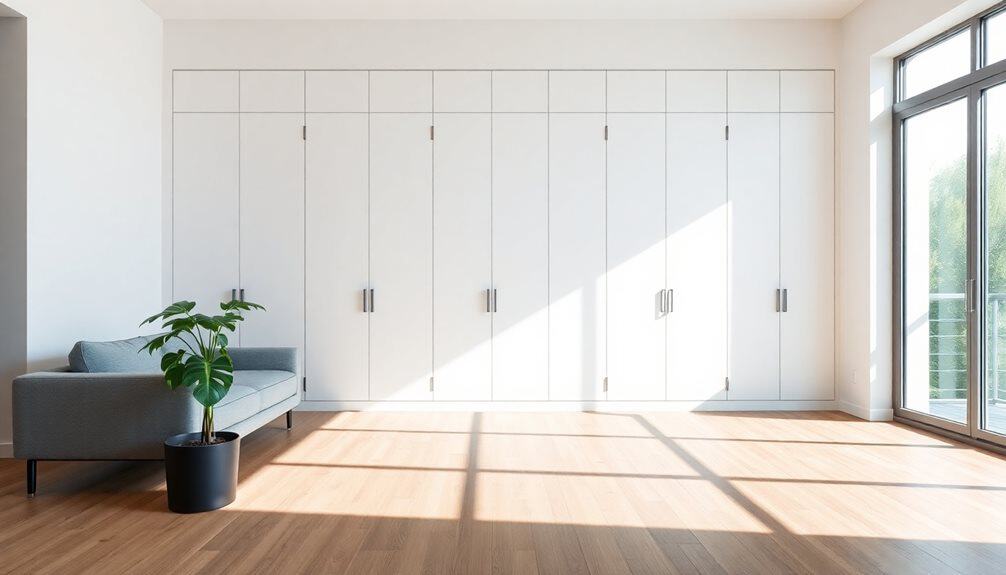
The essence of minimalist living lies in creating purposeful storage solutions that eliminate visual clutter while maximizing your space’s functionality. Start by investing in multi-functional furniture pieces like ottoman storage benches, lift-top coffee tables, and platform beds with built-in drawers. These dual-purpose items help you maintain clean lines while concealing everyday essentials.
Install floating shelves and wall-mounted cabinets to utilize vertical space effectively. They’ll keep your floors clear while providing dedicated zones for books, decor, and necessary items. Consider sleek, handle-free storage units that blend seamlessly into walls, creating an uninterrupted visual flow throughout your space.
Organize closets and drawers with modular storage systems, using clear containers and drawer dividers to keep items visible yet contained. Implement the “one in, one out” rule: whenever you acquire something new, remove an existing item to maintain balance. Don’t forget to maximize often-overlooked spaces like under-sink areas and door backs with slim organizers and hooks. By implementing these strategic storage solutions, you’ll create a serene environment where everything has its place, allowing your carefully chosen decor pieces to truly shine. For maximum door storage efficiency, choose 600D Oxford fabric organizers that can support up to 400 pounds of weight while maintaining durability.
Curate Meaningful Decor Pieces
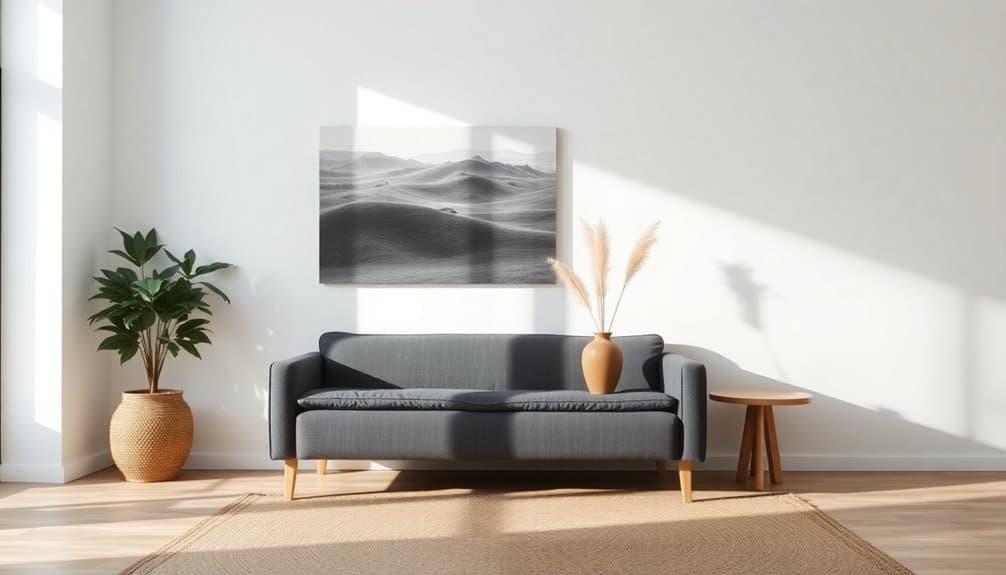
With your storage solutions expertly organized, it’s time to focus on selecting decor pieces that tell your story while maintaining minimalist principles. Choose items that serve both aesthetic and emotional purposes – perhaps a handcrafted ceramic vase from your travels or a striking black-and-white photograph that captures a significant moment in your life.
Limit yourself to 2-3 carefully chosen pieces per room, ensuring each item earns its place through meaning and visual impact. When selecting artwork, opt for larger statement pieces rather than clusters of smaller frames, which can create visual clutter. Natural materials like stone, wood, and linen add warmth while maintaining clean lines and neutral palettes.
Consider the negative space around each piece as part of your design strategy. This breathing room allows meaningful objects to stand out and create visual harmony. Don’t feel pressured to fill every surface – instead, rotate seasonal items or special pieces to keep your space fresh and intentional. Remember, in minimalist design, each object should contribute to your home’s story without overwhelming the space’s peaceful atmosphere.
The kitchen offers unique opportunities to showcase minimalist decor elements while maintaining functionality and style.
Frequently Asked Questions
How Much Does It Cost to Transition to a Minimalist Home Style?
You’ll find changing to a minimalist home style can range from $500 to $5,000, depending on your starting point and approach. If you’re starting fresh, invest in quality, multi-functional furniture pieces ($1,000-3,000), decluttering tools ($100-200), and storage solutions ($200-500). You can reduce costs by selling excess items and choosing budget-friendly retailers like IKEA or Target for essential pieces.
Can Minimalist Design Work in Small Apartments or Studio Spaces?
Sleek, simple spaces shine spectacularly in small apartments! You’ll find minimalist design works wonders in compact areas by maximizing every inch. Create vertical storage solutions, opt for multi-functional furniture, and embrace negative space to make your studio feel airy. Choose light colors and reflective surfaces to amplify natural light. Don’t forget to declutter regularly – less truly becomes more when you’re working with limited square footage.
What’s the Best Way to Convince Family Members to Adopt Minimalism?
You’ll want to lead by example rather than pushing your minimalist lifestyle onto family members. Start by decluttering your own space and letting them witness the positive changes in your life. Share specific benefits you’ve experienced, like reduced stress or better sleep. When they show interest, offer gentle suggestions and invite them to experiment with small areas first, like a drawer or closet.
How Often Should You Evaluate and Declutter a Minimalist Space?
Studies show the average home has over 300,000 items, making regular decluttering essential. You’ll want to evaluate your space quarterly for a thorough review, with mini-assessments monthly. Create a seasonal rotation schedule – spring for deep cleaning, summer for wardrobe, fall for entertainment items, and winter for storage spaces. Don’t forget weekly quick scans of high-traffic areas to maintain your carefully curated aesthetic.
Are Plants and Natural Elements Considered Minimalist Decor Pieces?
Plants and natural elements absolutely fit into minimalist design principles. You’ll find they add organic texture and life while maintaining clean aesthetics. Opt for sculptural varieties like snake plants, fiddle leaf figs, or ZZ plants in sleek planters. Incorporate natural materials like stone, wood, or bamboo thoughtfully – they’ll create warmth without clutter. Just remember to keep your plant collection curated and intentional.




